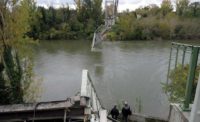Investigations continued last week into the causes of two separate, fatal accidents at major bridge projects but investigators still have more questions than answers.
In Toledo, Ohio, contractors were picking up after the Feb. 16 collapse of a 2-million-lb, 315-ft-long launching truss for the Maumee River Bridge but work continued on other sections of the $220-million project. Four workers were killed in the accident. But work was still halted last week on a $96-million Sikorsky Bridge replacement in Stratford, Conn., where a crane operator was killed after the barge-mounted crane plunged into the river (ENR 2/23 p. 10).
In Toledo, teams from the U.S. Occupational Safety and Health Administration, Ohio Dept. of Transportation and representatives of Paola de Nicola, the Italian truss manufacturer, are investigating why the equipment failed. Fru-Con Construction Corp., St. Louis, has 240 people still working on the north approach and casting yard. ODOT spokesman Joe Rutherford says the agency expects a "work forward" plan to be submitted within six weeks for finishing the job, which was 14 months ahead of schedule when the accident occurred.
|
"We will move forward only after we determine the exact cause of the accident," says Edward F. Neumann, Fru-Con vice president of civil business. The second truss and a ramp truss will be independently reviewed for safety. Should Fru-Con forego using the second truss, it could fabricate or find a replacement or research alternate erection techniques.
Fru-Cons German parent, Bilfinger Berger AG, recently used a similar truss made by the Italian firm on a Taiwan high-speed rail project that featured heavier precast concrete segments than Maumees 10-ft-long, 80-ton segments, Neumann notes. Fru-Cons records indicate no previous bridge project fatalities since at least 1960, he says.
At the Sikorsky Bridge, work was still on hold last week as state police and crane inspectors investigated. Charles Jordan, 60, of Satsuma, Ala., died of blunt trauma after his crane, which was lifting a steel beam off the old bridge being demolished, collapsed.
"All demolition work on the project has ceased and will not begin again until the company and regulators are satisfied that it is appropriate to restart," contractor Balfour Beatty Construction Inc., Atlanta, said in a statement. "The investigation will center on why this tragedy occurred and how similar accidents can be prevented," said Bill Ogle, president and CEO.
The firm had paid a $2,500 fine in 2001 when an excavator fell into the river, according to OSHA records. No one was injured in that mishap. Balfour Beatty says the last lost-time accident at the site was in June 2002.
The new steel plate girder bridge, originally bid at $83.7 million, was to be completed this spring but had been pushed back to 2005 due to subsurface conditions, says Paul Breen, assistant director of the Connecticut Dept. of Transportation. The tidal river made building new concrete piers adjacent to existing piers difficult, he says. The new piers are built at a different angle to reduce scour. Balfour Beatty was 30% complete with demolishing the old bridge.
Photos by AP Wideworld


Post a comment to this article
Report Abusive Comment